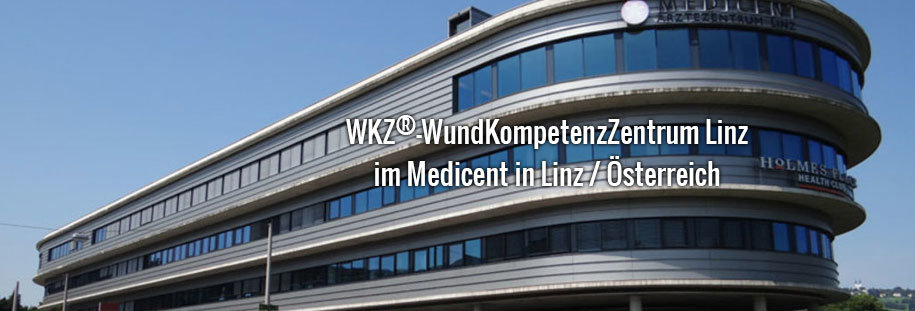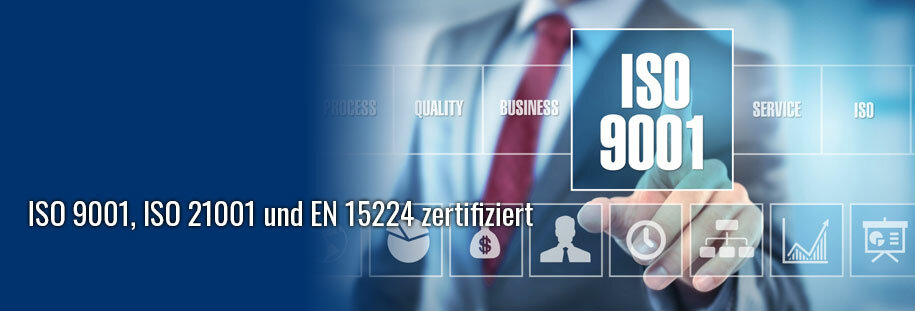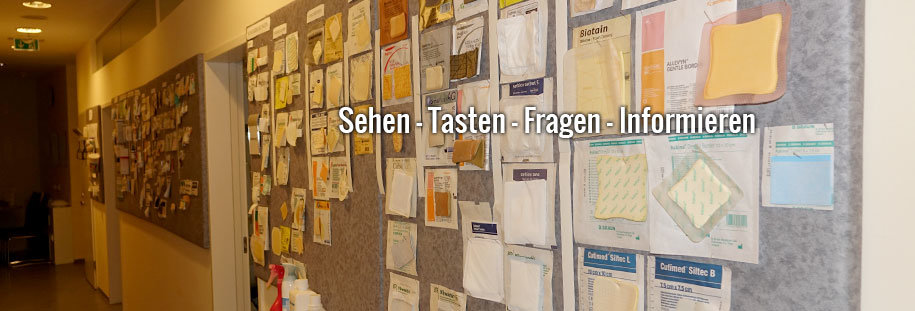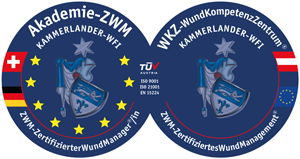 Akademie-ZWM®
Akademie-ZWM®Shop

Wund-Literatur
Alginate
Claims for AQUACEL® Ag Dressing
| Antimicrobial | |
| Claim | Reference(s) |
Ionic silver starts killing a broad spectrum of pathogens within 30 minutes of exposure to the dressing as demonstrated by in vitro testing, including MRSA and VRE. [Note: The list of pathogens listed in Table 1 of the Jones (2004) reference (right) may be reproduced (with permission) for this claim. For convenience, Table 1 of this reference appears in this document at the end of the Antimicrobial Claims section.] | Jones SA, Bowler PG, Walker M, Parsons D. Controlling wound bioburden with a novel silver-containing Hydrofiber® dressing. Wound Repair Regen. 2004 May-Jun;12(3):288-94. |
[Note: The list of pathogens listed in Table 1 of the Jones (2004) reference (right) may be reproduced (with permission) for this claim. For convenience, Table 1 of this reference appears in this document at the end of the Antimicrobial Claims section.] | Jones SA, Bowler PG, Walker M, Parsons D. Controlling wound bioburden with a novel silver-containing Hydrofiber dressing. Wound Repair Regen. 2004 May-Jun;12(3):288-94. |
AQUACEL® Ag dressing has broad-spectrum bactericidal activity in vitro.
| Jones SA, Bowler PG, Walker M, Parsons D. Controlling wound bioburden with a novel silver-containing Hydrofiber dressing. Wound Repair Regen. 2004 May-Jun;12(3):288-94. |
[Note: The list of pathogens listed in Table 1 of the Jones (2004) reference (right) may be reproduced (with permission) for this claim. For convenience, Table 1 of this reference appears in this document at the end of the Antimicrobial Claims section.] | Jones SA, Bowler PG, Walker M, Parsons D. Controlling wound bioburden with a novel silver-containing Hydrofiber dressing. Wound Repair Regen. 2004 May-Jun;12(3):288-94. |
In vitro studies with AQUACEL® Ag dressing have demonstrated microbicidal activity against a wide range of pathogens up to a period of 14 days.* *See package insert for instructions for use. | Bowler PG, Jones SA, Walker M, Parsons D. Microbicidal properties of a silver-containing hydrofiber dressing against a variety of burn wound pathogens. J Burn Care Rehabil. 2004 Mar-Apr;25(2):192-6. |
AQUACEL® Ag dressing maintained antimicrobial activity even after reinoculation of microorganisms in laboratory studies. | Bowler PG, Jones SA, Walker M, Parsons D. Microbicidal properties of a silver-containing hydrofiber dressing against a variety of burn wound pathogens. J Burn Care Rehabil. 2004 Mar-Apr;25(2):192-6. |
*See package insert for instructions for use. | Bowler PG, Jones SA, Walker M, Parsons D. Microbicidal properties of a silver-containing hydrofiber dressing against a variety of burn wound pathogens. J Burn Care Rehabil. 2004 Mar-Apr;25(2):192-6. |
The silver in the dressing:
| AQUACEL® Ag with Hydrofiber® Silver Impregnated Antimicrobial Dressing [US package insert ConvaTec 1137335A2]. Princeton, NJ: ER Squibb & Sons LLC; 2003. |
The silver in the dressing kills wound bacteria held in the dressing. | AQUACEL® Ag with Hydrofiber® Silver Impregnated Antimicrobial Dressing [US package insert ConvaTec 1137335A2]. Princeton, NJ: ER Squibb & Sons LLC; 2003. |
The silver in the dressing reduces the number of bacteria where the dressing conforms to the wound. | AQUACEL® Ag with Hydrofiber® Silver Impregnated Antimicrobial Dressing [US package insert ConvaTec 1137335A2]. Princeton, NJ: ER Squibb & Sons LLC; 2003. |
The silver in the dressing aids in creating an antimicrobial environment. | AQUACEL® Ag with Hydrofiber® Silver Impregnated Antimicrobial Dressing [US package insert ConvaTec 1137335A2]. Princeton, NJ: ER Squibb & Sons LLC; 2003. |
In in vitro studies, ionic silver in the dressing has been shown to kill a broad spectrum of wound pathogens, which can cause infection. | Jones SA, Bowler PG, Walker M, Parsons D. Controlling wound bioburden with a novel silver-containing Hydrofiber dressing. Wound Repair Regen. 2004 May-Jun;12(3):288-94. Bowler PG, Jones SA, Walker M, Parsons D. Microbicidal properties of a silver-containing hydrofiber dressing against a variety of burn wound pathogens. J Burn Care Rehabil. 2004 Mar-Apr;25(2):192-6 |
In vitro data show that AQUACEL® Ag dressing kills potentially pathogenic bacteria within the dressing. | Newman GR, Walker M, Hobot JA, Bowler PG. Visualisation of bacterial sequestration and bactericidal activity within hydrating Hydrofiber wound dressings. Biomaterials. 2006 Mar;27(7):1129-39. Epub 2005 Aug 24. |
Silver is bactericidal only in its ionic state. | Demling RH, De Santi L. Effects of silver on wound management. WOUNDS. 2001;13 (suppl A):4-15. Simonetti N, Simonetti G, Bougnol F, Scalzo M. Electrochemical Ag+ for preservative use. Appl Environ Microbiol. 1992 Dec;58(12):3834-6. |
Gauze can release bacteria into the air during dressing removal. | Lawrence JC, Lilly HA, Kidson A. Wound dressings and airborne dispersal of bacteria. Lancet. 1992 Mar 28;339(8796):807. |
| Jones SA, Bowler PG, Walker M, Parsons D. Controlling wound bioburden with a novel silver-containing Hydrofiber dressing. Wound Repair Regen. 2004 May-Jun;12(3):288-94. |
| Conformability | |
In in vitro studies using uneven agar plates and simulated wound conditions, AQUACEL® Ag dressing conformed well under both test conditions. | Parsons D, Bowler PG, Myles V, Jones S. Silver antimicrobial dressings in wound management: A comparison of antibacterial, physical, and chemical characteristics. WOUNDS. 2005;17(8):222-232. |
| Wicking and Absorption | |
By virtue of its gel blocking properties, the dressing absorbs exudate, containing bacteria, and retains it within its fibers. | Bowler PG, Jones SA, Davies BJ, Coyle E. Infection control properties of some wound dressings. J Wound Care. 1999 Nov;8(10):499-502. Walker M, Hobot JA, Newman GR, Bowler PG. Scanning electron microscopic examination of bacterial immobilisation in a carboxymethyl cellulose (AQUACEL®) and alginate dressings. Biomaterials. 2003;24:883-890. |
| Healing and Wear Time | |
AQUACEL® Ag dressing absorbs wound fluid and bacteria and creates a soft, cohesive gel, which maintains a moist wound environment that promotes autolytic debridement and supports the body’s healing process. | AQUACEL® Ag with Hydrofiber® Silver Impregnated Antimicrobial Dressing [US package insert ConvaTec 1137335A2]. Princeton, NJ: ER Squibb & Sons LLC; 2003. AQUACEL® Ag Hydrofiber® Wound Dressing [CE Mark package insert ConvaTec 1137338]. Deeside, UK: ConvaTec Limited; 2002. |
AQUACEL® Ag dressing absorbs wound fluid and creates a soft gel, which maintains a moist wound environment that aids autolytic debridement. |
AQUACEL® Ag Hydrofiber® Wound Dressing [CE Mark package insert ConvaTec 1137338]. Deeside, UK: ConvaTec Limited; 2002. |
AQUACEL® Ag dressing absorbs wound fluid and creates a soft gel, which maintains a moist wound environment that supports the body’s healing process. |
AQUACEL® Ag Hydrofiber® Wound Dressing [CE Mark package insert ConvaTec 1137338]. Deeside, UK: ConvaTec Limited; 2002. |
| Pain | |
In 15 evaluable patients with chronic leg ulcers managed with AQUACEL® Ag dressing, pain scores from baseline to final evaluation were significantly reduced for both dressing in place and during removal (P=.05). | Vanscheidt W, Lazareth I, Routkovsky-Norval C. Safety evaluation of a new ionic silver dressing in the management of chronic ulcers. Wounds. 2003;15(11):371-378. |
In a partial-thickness burn study, use of AQUACEL® Ag dressing showed a reduction in analgesic use compared to silver sulfadiazine. | Caruso DM, Foster KN, Blome-Eberwein SA, Twomey JA, Herndon DN, Luterman A, Silverstein P, Antimarino JR, Bauer GJ. Randomized clinical study of Hydrofiber dressing with silver or silver sulfadiazine in the management of partial-thickness burns. J Burn Care Res. 2006 May-Jun;27(3):298-309. |
In a partial-thickness burn study, patients over the age of 4 years reported significantly less pain overall during changes (P=.039) of AQUACEL® Ag dressing compared to silver sulfadiazine. | Caruso DM, Foster KN, Blome-Eberwein SA, Twomey JA, Herndon DN, Luterman A, Silverstein P, Antimarino JR, Bauer GJ. Randomized clinical study of Hydrofiber dressing with silver or silver sulfadiazine in the management of partial-thickness burns. J Burn Care Res. 2006 May-Jun;27(3):298-309. |
The use of AQUACEL® Ag dressing was associated with significantly less pain (P=.009) and anxiety (P=.002) compared to silver sulfadiazine during dressing changes in a partial-thickness burn study. | Caruso DM, Foster KN, Blome-Eberwein SA, Twomey JA, Herndon DN, Luterman A, Silverstein P, Antimarino JR, Bauer GJ. Randomized clinical study of Hydrofiber dressing with silver or silver sulfadiazine in the management of partial-thickness burns. J Burn Care Res. 2006 May-Jun;27(3):298-309. |
Patients over the age of 4 years reported significantly less burning or stinging overall during wear (P=.022) with AQUACEL® Ag dressing compared to silver sulfadiazine in a partial-thickness burn study. | Caruso DM, Foster KN, Blome-Eberwein SA, Twomey JA, Herndon DN, Luterman A, Silverstein P, Antimarino JR, Bauer GJ. Randomized clinical study of Hydrofiber dressing with silver or silver sulfadiazine in the management of partial-thickness burns. J Burn Care Res. 2006 May-Jun;27(3):298-309. |
| Cost | |
AQUACEL® Ag dressing resulted in a 28% reduction in the cost per partial hickness burn healed compared to silver sulfadiazine. | Caruso DM, Foster KN, Blome-Eberwein SA, Twomey JA, Herndon DN, Luterman A, Silverstein P, Antimarino JR, Bauer GJ. Randomized clinical study of Hydrofiber dressing with silver or silver sulfadiazine in the management of partial-thickness burns. J Burn Care Res. 2006 May-Jun;27(3):298-309. |
| Claims for AQUACEL® Ag Dressing | |
| Bacterial Sequestration | |
| Claim | Reference(s) |
| AQUACEL® dressing showed retention of 70% of pathogens tested (Pseudomonas aeruginosa and Staphylococcus aureus) in vitro. | Bowler PG, Jones SA, Davies BJ, Coyle E. Infection control properties of some wound dressings. J Wound Care. 1999 Nov;8(10):499-502. |
AQUACEL® dressing absorbs and retains exudate and harmful components, such as bacteria contained within exudate, directly into its fibers. | Walker M, Hobot JA, Newman GR, Bowler PG. Scanning electron microscopic examination of bacterial immobilisation in a carboxymethyl cellulose (AQUACEL®) and alginate dressings. Biomaterials. 2003;24:883-890. |
In an animal model, AQUACEL® dressing showed better retention of microorganisms (Pseudomonas aeruginosa and Staphylococcus aureus) than alginate dressings. | Tachi M, Hirabayashi S, Yonehara Y, Suzuki Y, Bowler P. Comparison of bacteria-retaining ability of absorbent wound dressings. Int Wound J. 2004 Sep;1(3):177-81. |
Scanning electron microscopy shows AQUACEL® dressing fibers trap bacteria, which may minimize release of bacteria into the air on removal. | Walker M, Hobot JA, Newman GR, Bowler PG. Scanning electron microscopic examination of bacterial immobilisation in a carboxymethyl cellulose (AQUACEL®) and alginate dressings. Biomaterials. 2003;24:883-890. |
Gauze can release bacteria into the air during removal. | Lawrence JC, Lilly HA, Kidson A. Wound dressings and airborne dispersal of bacteria. Lancet. 1992 Mar 28;339(8796):807. |
| Wicking and Absorption | |
Vertical wicking locks exudate in the AQUACEL® dressing, which may reduce the risk of maceration of peri-wound skin. | Waring MJ, Parsons D. Physico-chemical characterisation of carboxymethylated spun cellulose fibres. Biomaterials. 2001 May;22(9):903-12. |
| Walker M, Hobot JA, Newman GR, Bowler PG. Scanning electron microscopic examination of bacterial immobilisation in a carboxymethyl cellulose (AQUACEL®) and alginate dressings. Biomaterials. 2003;24:883-890. |
AQUACEL® dressing offers the unique gelling action of Hydrofiber® technology that absorbs and locks in exudate and bacteria. | Walker M, Hobot JA, Newman GR, Bowler PG. Scanning electron microscopic examination of bacterial immobilisation in a carboxymethyl cellulose (AQUACEL®) and alginate dressings. Biomaterials. 2003;24:883-890. |
By virtue of its gel blocking properties, AQUACEL® dressing absorbs exudate, containing bacteria, and retains it within its fibers. | Bowler PG, Jones SA, Davies BJ, Coyle E. Infection control properties of some wound dressings. J Wound Care. 1999 Nov;8(10):499-502. Walker M, Hobot JA, Newman GR, Bowler PG. Scanning electron microscopic examination of bacterial immobilisation in a carboxymethyl cellulose (AQUACEL®) and alginate dressings. Biomaterials. 2003;24:883-890. |
In a partial thickness wound rat model, AQUACEL® dressing rapidly absorbed and retained harmful components contained within exudate. | Hoekstra MJ, Hermans MH, Richters CD, Dutrieux RP. A histological comparison of acute inflammatory responses with a hydrofibre or tulle gauze dressing. J Wound Care. 2002 Mar;11(3):113-7. |
| Wound Contact and Removal | |
In an animal study, AQUACEL® dressing, in its gelled state, conforms to the wound surface, thereby reducing dead space. | Hoekstra MJ, Hermans MH, Richters CD, Dutrieux RP. A histological comparison of acute inflammatory responses with a hydrofibre or tulle gauze dressing. J Wound Care. 2002 Mar;11(3):113-7. |
* Registered trademark of Bertek Pharmaceuticals Inc. | Harding KG, Price P, Robinson B, Thomas S, Hofman D. Cost and dressing evaluation of hydrofiber and alginate dressings in the management of community-based patients with chronic leg ulceration. Wounds. 2001;13(6):229-236. |
AQUACEL® dressing in its gelled state allows non-traumatic removal. | [Claim based on gelling properties of the dressing] |
AQUACEL® dressing in its gelled state does not damage tender, granulating wound tissue or healthy tissue surrounding exudating wounds during dressing changes. | [Claim based on gelling properties of the dressing] |
| Healing and Wear Time | |
AQUACEL® dressing absorbs wound fluid and creates a soft gel, which maintains a moist wound environment that aids autolytic debridement and supports the body’s healing process. | AQUACEL® Hydrofiber® Wound Dressing [US package insert ConvaTec 1109469A3]. Princeton, NJ: ER Squibb & Sons LLC; 2004. AQUACEL® Hydrofiber® Wound Dressing [CE Mark package insert ConvaTec PE141D]. Deeside, UK: ConvaTec Limited; 1997. |
AQUACEL® dressing absorbs wound fluid and creates a soft gel, which maintains a moist wound environment that aids autolytic debridement. |
AQUACEL® Hydrofiber® Wound Dressing [CE Mark package insert ConvaTec PE141D]. Deeside, UK: ConvaTec Limited; 1997. |
AQUACEL® dressing absorbs wound fluid and creates a soft gel, which maintains a moist wound environment that supports the body’s healing process. |
AQUACEL® Hydrofiber® Wound Dressing [CE Mark package insert ConvaTec PE141D]. Deeside, UK: ConvaTec Limited; 1997. |
| Pain | |
In a study of 10 patients with pilonidal cysts, no pain was reported during changes of AQUACEL® dressing. | Andersson L, Mikkola S, Ewerth S, Akerlund J-E. A new wound dressing method after surgery on pilonidal cysts. In: AQUACEL®: New Dimensions in the treatment of post-surgical wounds. Proceedings of a satellite symposium at the 10th Conference of the European Wound Management Association, Stockholm, Sweden, 18-20 May 2000. Holsworthy, UK: Medical Communications; 2001:25-28. |
In a study of surgical wounds in 100 patients, mild or no pain was reported by 92% of the patients in the AQUACEL® dressing group and 80% of patients in the alginate group. | Foster L, Moore P, Clark S. A comparison of hydrofibre and alginate dressings on open acute surgical wounds. J Wound Care. 2000 Oct;9(9):442-5. |
In a study comparing AQUACEL® dressing to paraffin gauze in the management of donor sites, the AQUACEL® dressing sites were significantly less painful (P<.0001). | Barnea Y, Amir A, Leshem D, et al. Clinical comparative study of Aquacel and paraffin gauze dressing for split-skin donor site treatment. Ann Plast Surg. 2004 Aug;53(2):132-6. |
| Scarring | |
Using a modified Vancouver scar scale, independent observers rated scarring of donor sites as significantly better (P=.003) with AQUACEL® dressing compared to paraffin gauze. | Barnea Y, Amir A, Leshem D, et al. Clinical comparative study of Aquacel and paraffin gauze dressing for split-skin donor site treatment. Ann Plast Surg. 2004 Aug;53(2):132-6. |
Independent observers using a modified Vancouver scale, rated scarring of donor sites as significantly lower with AQUACEL® dressing than with paraffin gauze at 30, 60 and 90 days and at 1 year (P=.021, .012, .09, and .0091, respectively). | Barnea Y, Amir A, Leshem D, et al. Clinical comparative study of Aquacel and paraffin gauze dressing for split-skin donor site treatment. Ann Plast Surg. 2004 Aug;53(2):132-6. |
| Cost | |
In a clinical study of 40 patients, the average cost of each episode in acute surgical wounds left to heal by secondary intention was less with AQUACEL® dressing than ribbon gauze soaked in proflavine. | Moore PJ, Foster L. Cost benefits of two dressings in the management of surgical wounds.Br J Nurs. 2000 Sep 28-Oct 11;9(17):1128-32. |
AQUACEL® dressing, in a 40-patient study, demonstrated nearly 50% reduction in nursing time for dressing changes compared to gauze in the management of surgical wounds healing by secondary intention. | Moore PJ, Foster L. Cost benefits of two dressings in the management of surgical wounds.Br J Nurs. 2000 Sep 28-Oct 11;9(17):1128-32. |
AQUACEL® dressing was less costly than gauze dressing in the management of open wounds. |
Hensley BJ. Dealing with a nursing shortage? Aquacel® Hydrofiber® dressing can help [ConvaTec W031-983]. Poster presented at: The Association for the Advancement of Wound Care 15th Annual Symposium on Advanced Wound Care & 12th Annual Medical Research Forum on Wound Repair; April 27-30, 2002; Baltimore, Md. |
AQUACEL® dressing reduces nursing time when compared to gauze dressings in the management of open wounds. |
Moore PJ, Foster L. Cost benefits of two dressings in the management of surgical wounds.Br J Nurs. 2000 Sep 28-Oct 11;9(17):1128-32. |
Evaluation of a new composite dressing for the management of chronic leg ulcer wounds.
J Wound Care. 2002 Sep;11(8):290-4.
PMID: 12360762 [PubMed - indexed for MEDLINE]
Foster L, Smith E, Moore P, Turton P.
The use of a hydrofibre dressing in fulminating necrotizing fasciitis.
Br J Nurs. 2001 Jun 28-Jul 11;10(11 Suppl):S36-8, S41-2.
PMID: 12146180 [PubMed - indexed for MEDLINE]
Hoekstra MJ, Hermans MH, Richters CD, Dutrieux RP.
A histological comparison of acute inflammatory responses with a hydrofibre or tulle gauze dressing.
J Wound Care. 2002 Mar;11(3):113-7.
PMID: 11933728 [PubMed - indexed for MEDLINE]
A comparison of hydrofibre and alginate dressings on open acute surgical wounds.
J Wound Care. 2000 Oct;9(9):442-5.
PMID: 11933488 [PubMed - in process]
New hydrofibre and hydrocolloid dressings for chronic wounds.
J Wound Care. 2000 Apr;9(4):169-72. No abstract available.
PMID: 11933300 [PubMed - in process]
Cost benefits of two dressings in the management of surgical wounds.
Br J Nurs. 2000 Sep 28-Oct 11;9(17):1128-32.
PMID: 11868167 [PubMed - indexed for MEDLINE]
Vloemans AF, Soesman AM, Kreis RW, Middelkoop E.
A newly developed hydrofibre dressing, in the treatment of partial-thickness burns.
Burns. 2001 Mar;27(2):167-73.
PMID: 11226656 [PubMed - indexed for MEDLINE]
Experiences with hydrofibres in the moist treatment of chronic wounds, in particular of diabetic foot.
Vasa. 2000 Nov;29(4):253-7.
PMID: 11141647 [PubMed - indexed for MEDLINE]
The use of a hydrofibre dressing in wound management.
J Wound Care. 2000 Jan;9(1):32-4. Review. No abstract available.
PMID: 10827666 [PubMed - indexed for MEDLINE]
Bowler PG, Jones SA, Davies BJ, Coyle E.
Infection control properties of some wound dressings.
J Wound Care. 1999 Nov;8(10):499-502.
PMID: 10827654 [PubMed - indexed for MEDLINE]
Moore P, Foster L, Clark S, Parrott D.
The role of a hydrofibre dressing in squamous cell carcinoma of the anal canal.
J Wound Care. 1999 Oct;8(9):432-4. No abstract available.
PMID: 10818891 [PubMed - indexed for MEDLINE]
An investigation of the benefits of Aquacel Hydrofibre wound dressing.
Br J Nurs. 1999 May 27-Jun 9;8(10):676-7, 680. Review.
PMID: 10624199 [PubMed - indexed for MEDLINE]
Alginates and hydrofibre dressings.
Prof Nurse. 1999 Apr;14(7):496-9, 501, 503.
PMID: 10347532 [PubMed - indexed for MEDLINE]
Use of a fibrous dressing in exuding leg ulcers.
J Wound Care. 1997 Jul;6(7):322-4.
PMID: 9325826 [PubMed - indexed for MEDLINE]
[Case report about the combined use of 2 moist wound dressings in the treatment of a chronic diabetic foot ulcer]
Rev Enferm. 1998 Oct;21(242):suppl 9-12. Spanish.
PMID: 10030155 [PubMed - indexed for MEDLINE]
Legarra Muruzaba S, Vidallach Ribes MS, Esteban Gonzalo M.
[Non-comparative evaluation of a new hydrofiber dressing in the treatment of vascular ulcers]
Rev Enferm. 1997 Nov;20(231):59-63. Spanish.
PMID: 9451237 [PubMed - indexed for MEDLINE]






